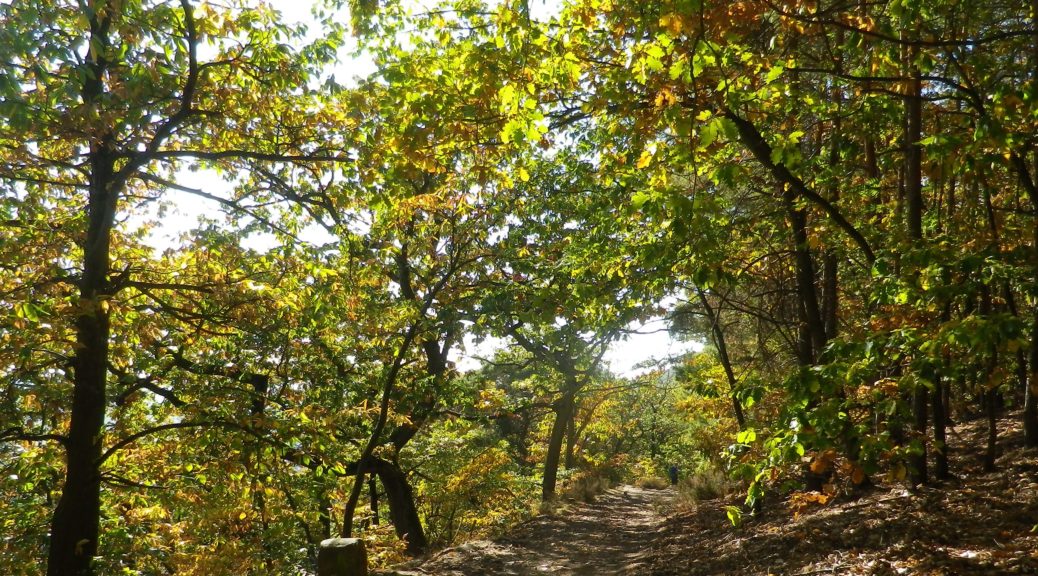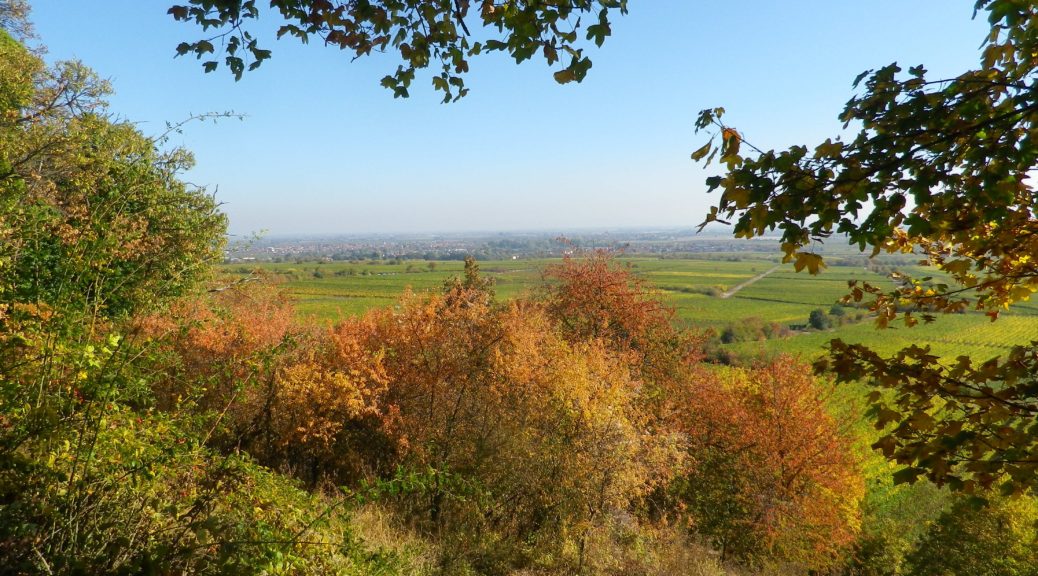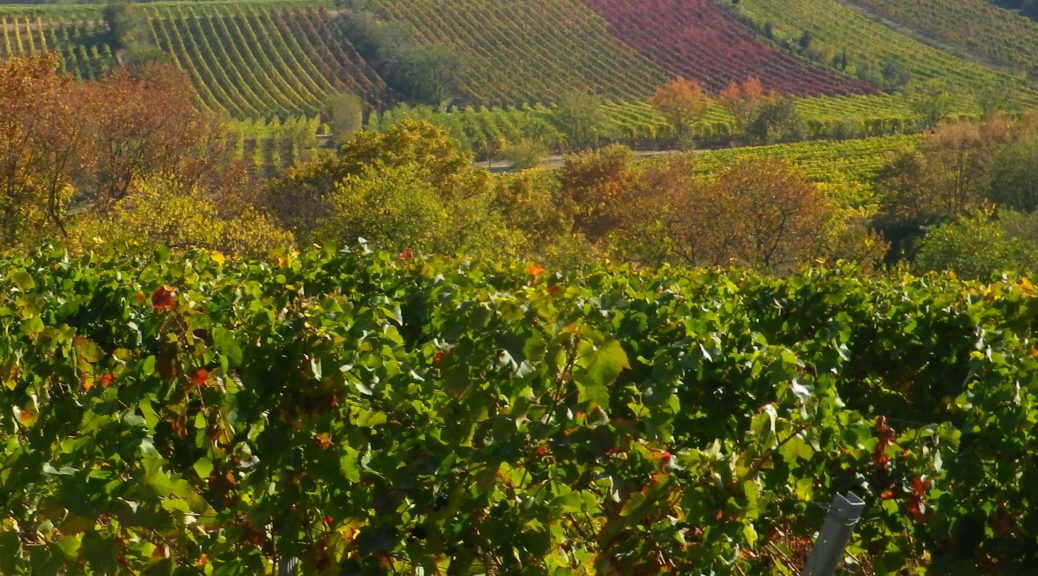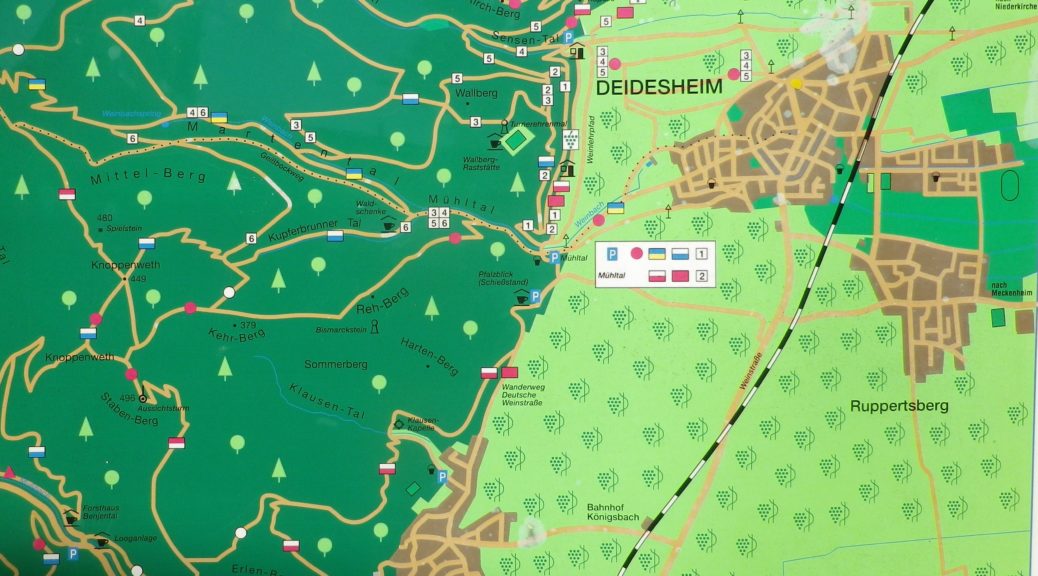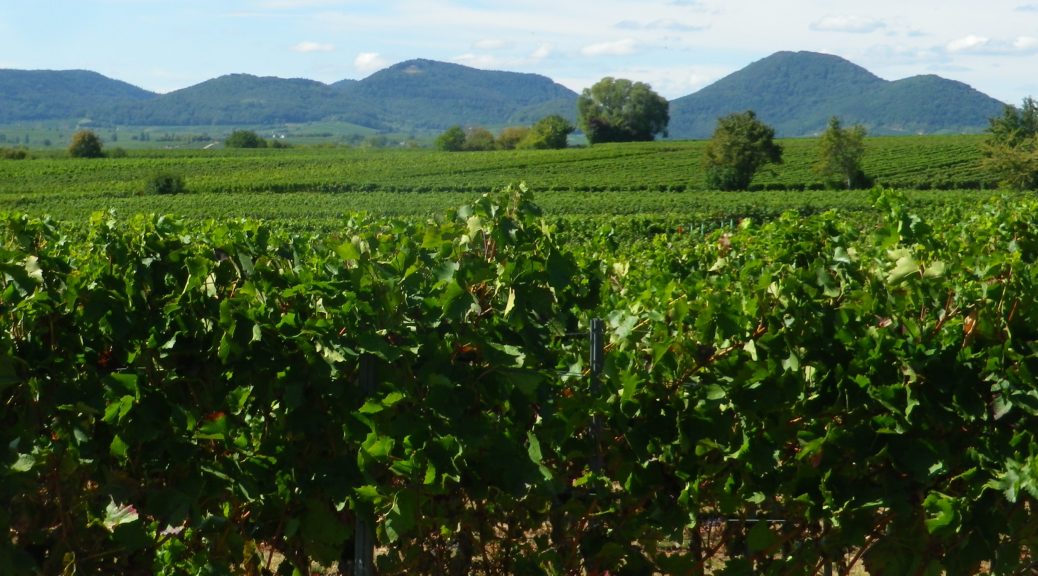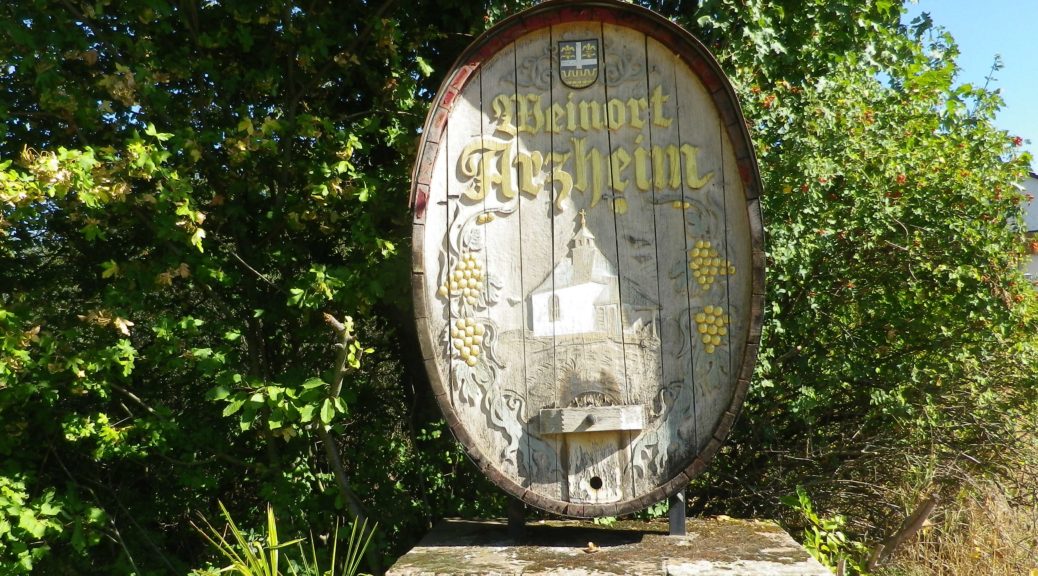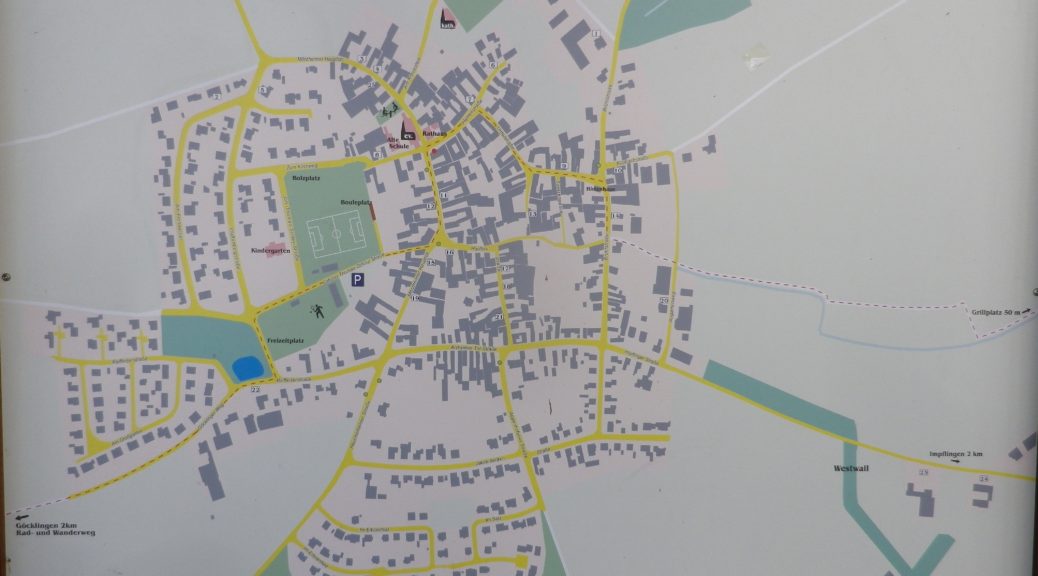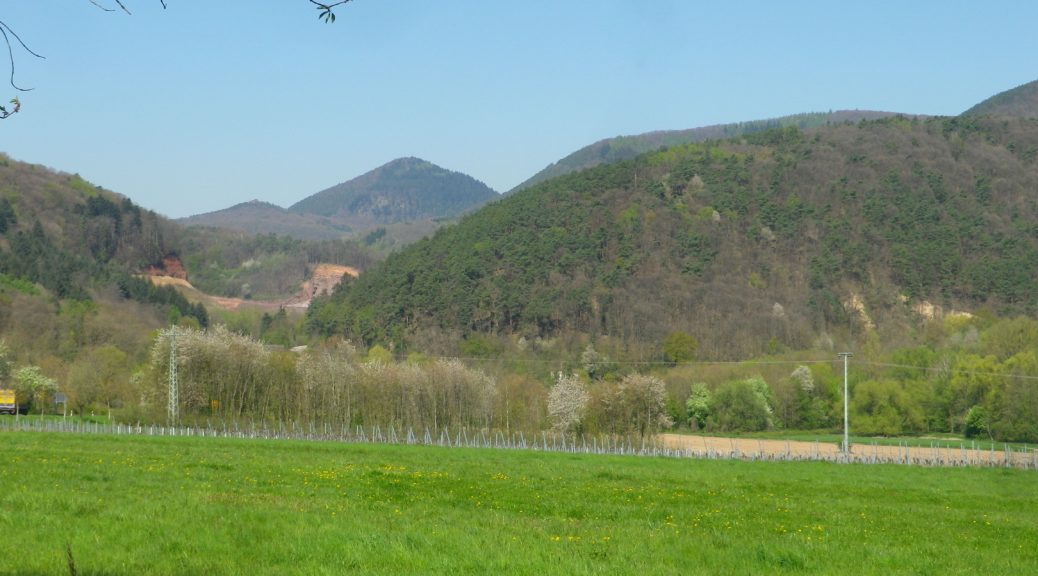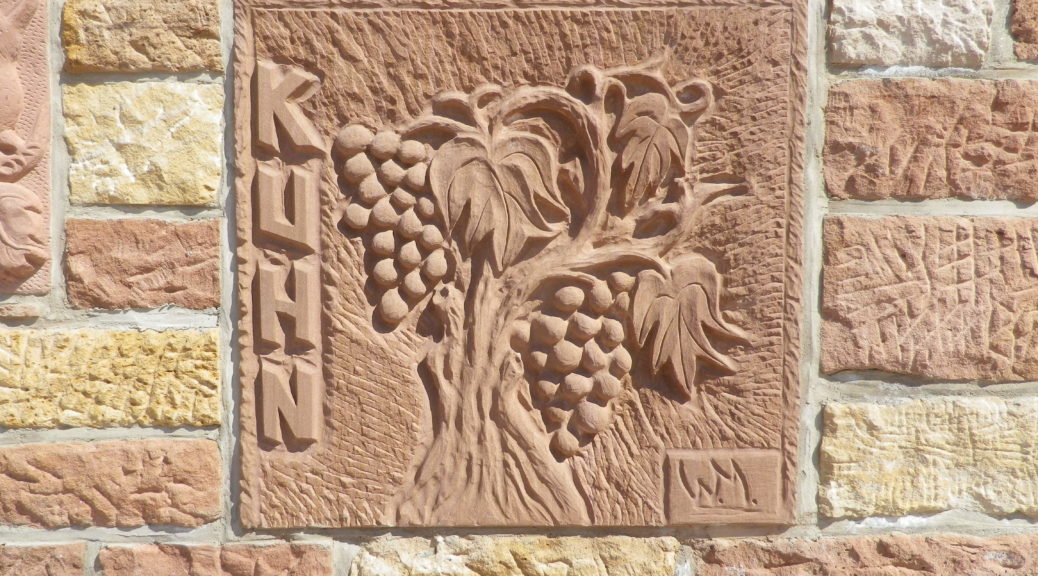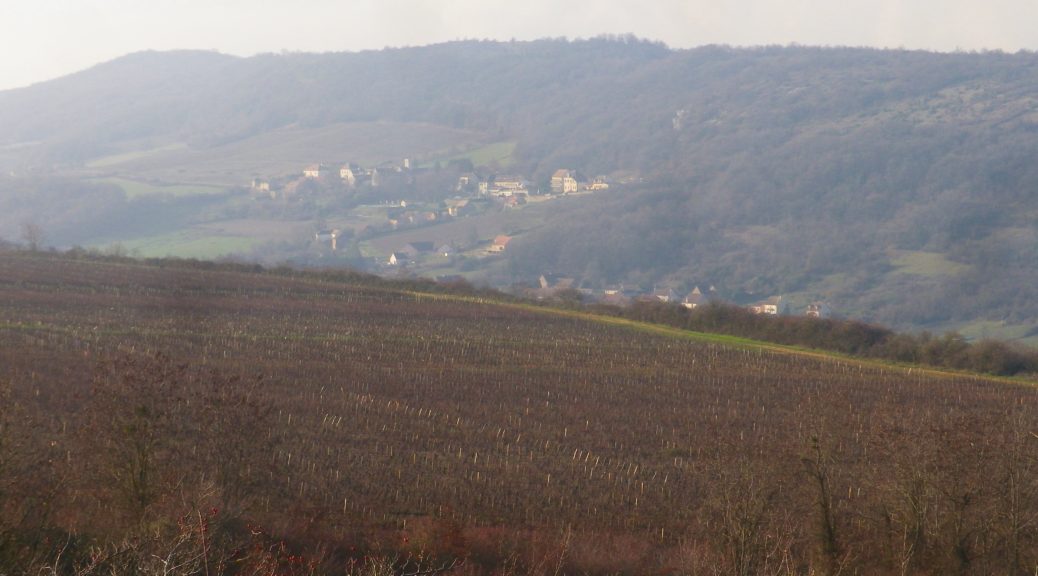Tag Archives: Pfalz
Climbing for Wine
The climbs were steep, but the views were very rewarding. With more time, I would have done more climbs. In fact, in my castle hiking days, I had already hiked to several highpoints and castles on this trail: the Neuleiningen, the Wachtenburg, Hambacher Schloss, the Kalmit lookout, and that is just in the Mittelhaardt district. But at 185 kilometers, I didn’t have enough vacation days left! So perhaps on some other trip to Germany, I will be able to complete the Pfaelzer Weinsteig Trail.
For hikers looking for an intimate experience of the Pfalz wine region, this trail covers much of the region, as does the Wanderweg (Hiking Trail) Deutsche Weinstrasse (see the Nutshells here and here). The similarities between the two is that each pass through famous wine towns and villages, where there are countless opportunities to sample the wines and visit wineries. They both also cover a variety of landscapes from urban, to vineyard to forest. The big difference is the level of difficulty. The Wanderweg Deutsche Weinstrasse is rather easy, with only a few steep climbs into woodlands. On the other hand, the Pfaelzer Weinsteig climbs from the villages, often located at the base of the hills, far into the hills of the Pfalzer Wald forest. In that sense, the trail is physically more challenging, and more diverse.
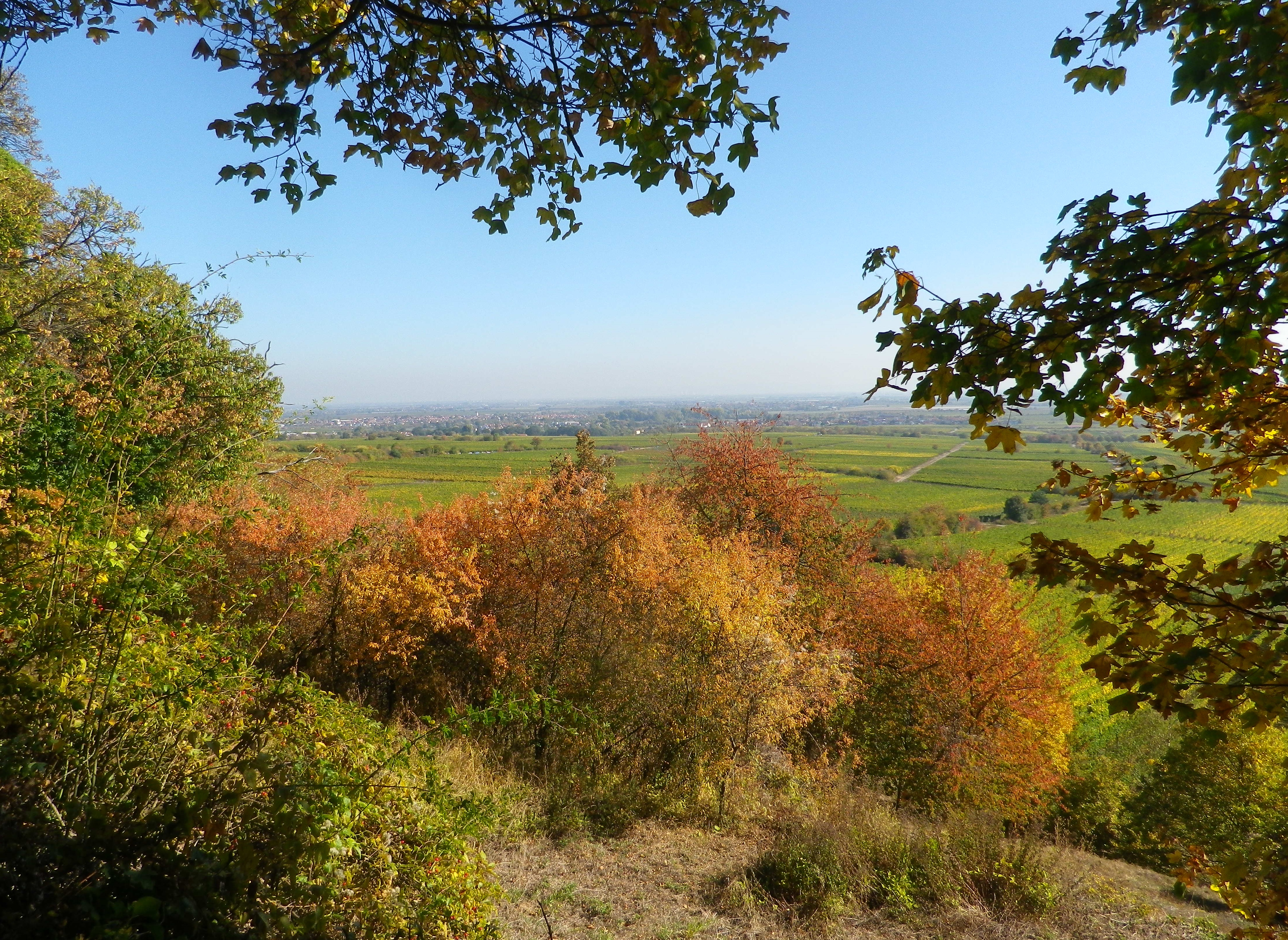
Wine Notes: Mittelhaardt
What I Learned
Germany’s Pfalz wine region is divided into two parts, the northern district of Mittelhaardt/Deutsche Weinstrasse, and the Suedliche Weinstrasse which is located south of Neustadt an der Weinstrasse. This entire region produces both red and white wines, with white wines making up approximately two-thirds of the overall annual production.
The Mittelhaardt/Deutsche Weinstrasse district runs along the Haardt mountains, facing east on gentle slopes in the optimal rain and wind shadow formed by the mountains covered by the majestic trees of the Pfaelzer Wald forest. This district, which begins in Bockenheim and continues to south of Neustadt, is in one of the warmest and sunniest regions of Germany. It contains towns and villages famous for their wines, as well as their lively wine festivals. Bad Duerkheim, with its Wurstmarkt in September, Neustadt with its Weinlese festival, in October, are two of the most famous wine festivals in Germany.
Pfaelzer Weinsteig: Trail in a Nutshell
Trail Name: Pfaelzer Weinsteig
Trail Type:
Long distance trail; well-maintained albeit with some rougher stretches along the segments through the forest and hills, naturally, marking on the trail very good overall
Length:
Total – 185 Kilometers/114 miles
Stage 4: 20 kilometers/12.5 miles (Deidesheim to Neustadt an der Weinstrasse)
My segment*- 7.5 kilometers/ miles (Train station, Deidesheim to Gimmeldingen)
Convenient to:
Bad Duerkheim or Neustadt an der Weinstrasse, Rheinland-Pfalz, Germany
Marking:
Red and white square, with white grapes on red background, trail name in red and white letters, alternatively simply red over white stripes
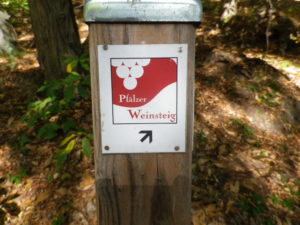
Vintners and Their Vines
As anyone who earns their living by the soil will tell you, the fields are important. As those who make their living by grapes know, each individual parcel of the vineyards is very important and rather unique. Like most vintners, those of Suedliche Weinstasse feel a deep connection with the land, and attempt to maximize the potential of the terroir and microclimate for each parcel, and carefully match that with each varietal planted. Parcels may be adjoining, or separated by a couple of kilometers. To access these, vintners use agricultural lanes, most of them as well tended as the vineyards they serve.
This bicycling itinerary led mostly along these lanes, through acres of vineyards, both in prime condition. The itinerary was called the Winzerradrundweg, or Vintner Bicycle Circuit Trail. Previously, vintners and vineyard workers, usually family, may have ridden bicycles to access distant parcels. Today though, they use cars, and compact trucks, and cyclists use these quiet lanes to explore this beautiful countryside.
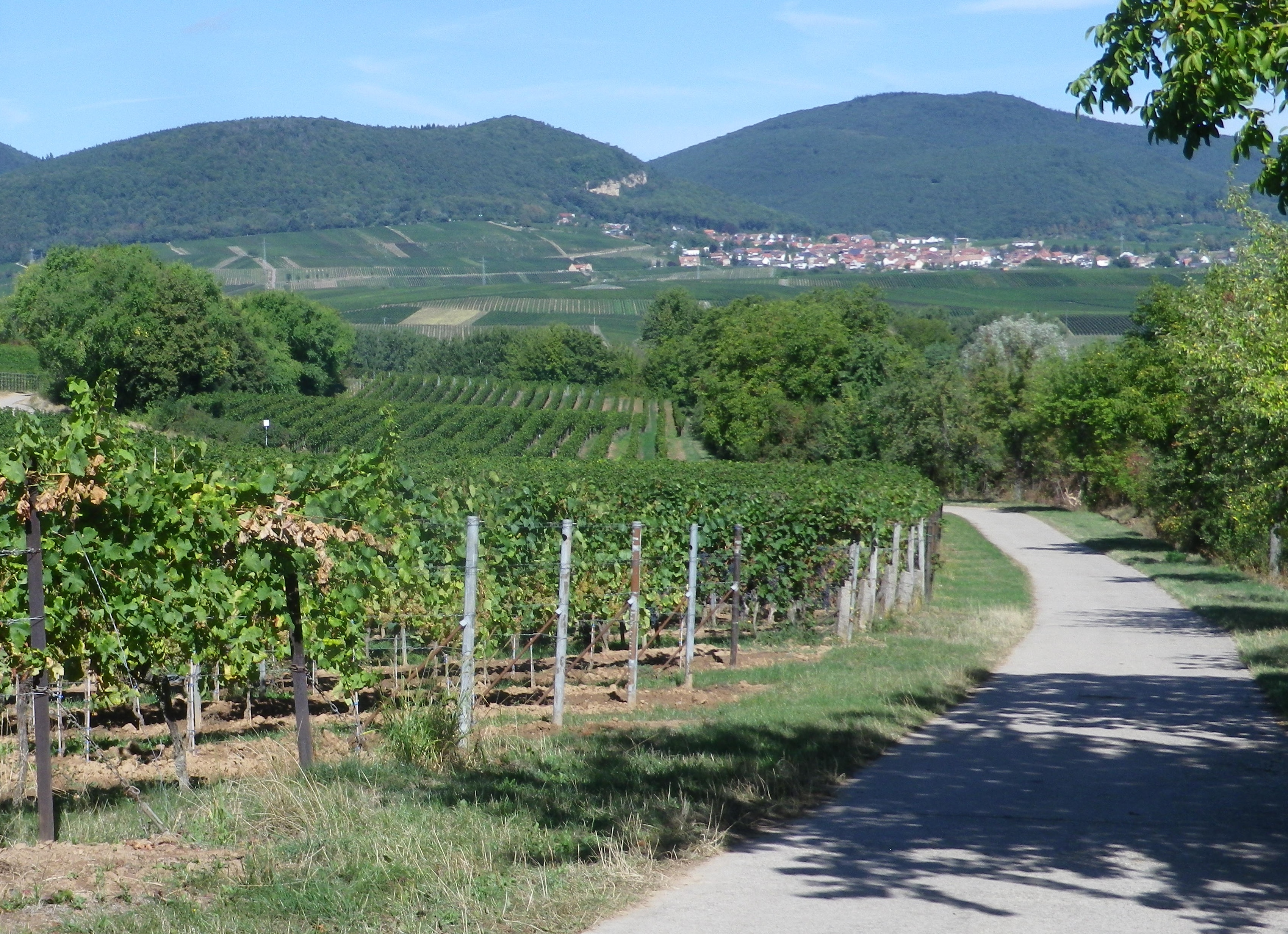
However, starting in the city of Landau in der Pfalz, the first two or three miles pass through wheat, corn and cabbage fields. There, I had my first encounter ever with a (John Deere!) farm combine. Curving upward from a steep gully, lined by high hedgerows, I first heard it, then only saw it, as it barreled down toward me on a lane rather narrow for it, let alone me and it. This thing was huge, about two stories tall! Happily, it suddenly veered to the right to begin harvesting the corn in an expansive golden field. Sadly, I didn’t get a photo. Shortly thereafter, I entered vine country, where such large machines are not used, not in Germany at least.
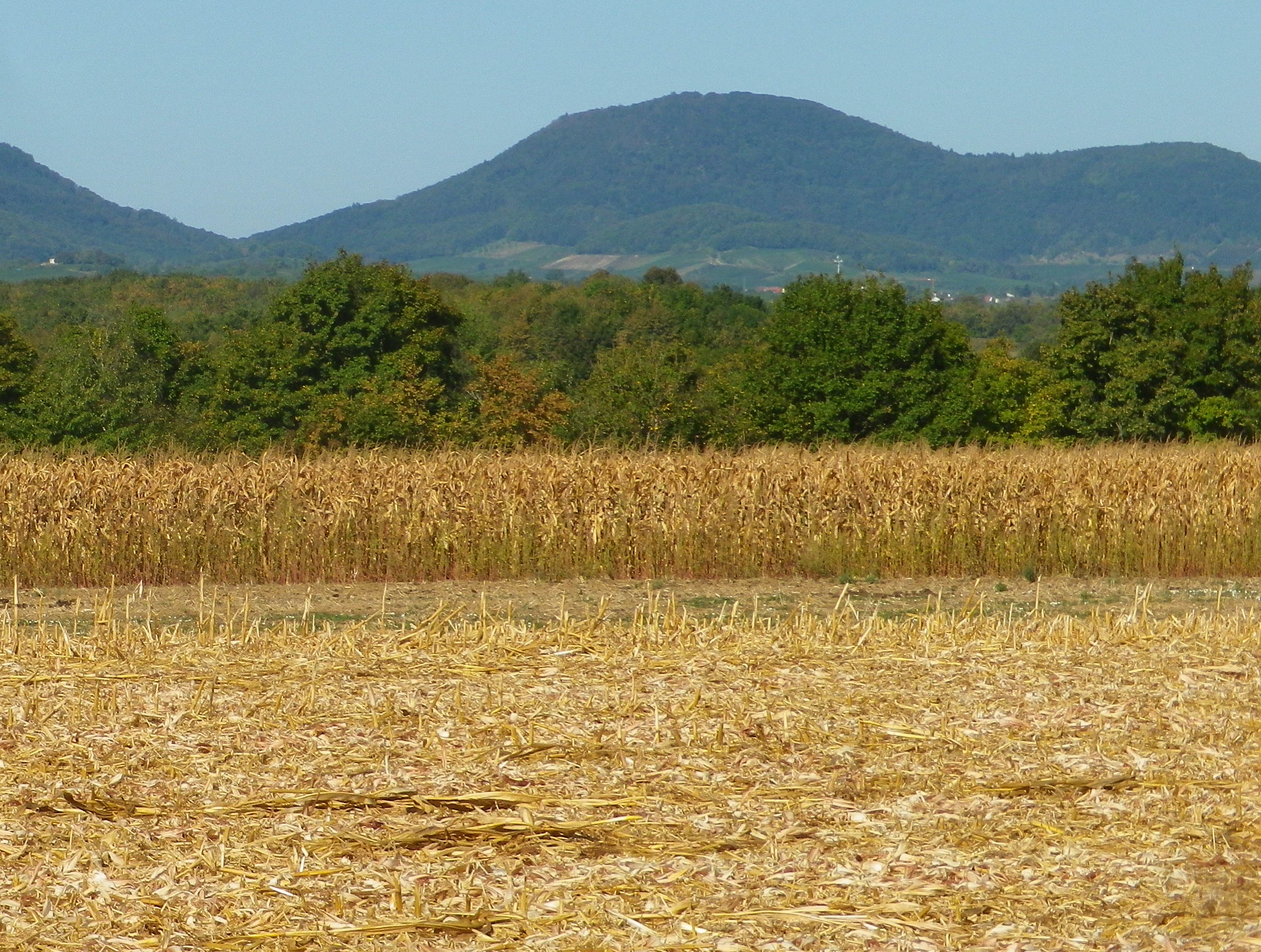
Two things to notice on this itinerary: the terrain for vines is distinctly different than the terrain for fruits and vegetables. The vineyards started where the flat fields left off, and hills or ridgelines began. The other noticeable difference was in the composition of the villages: the vintner family houses and businesses tended to be set in the villages, whereas the farmers tended to live on the edge of town.
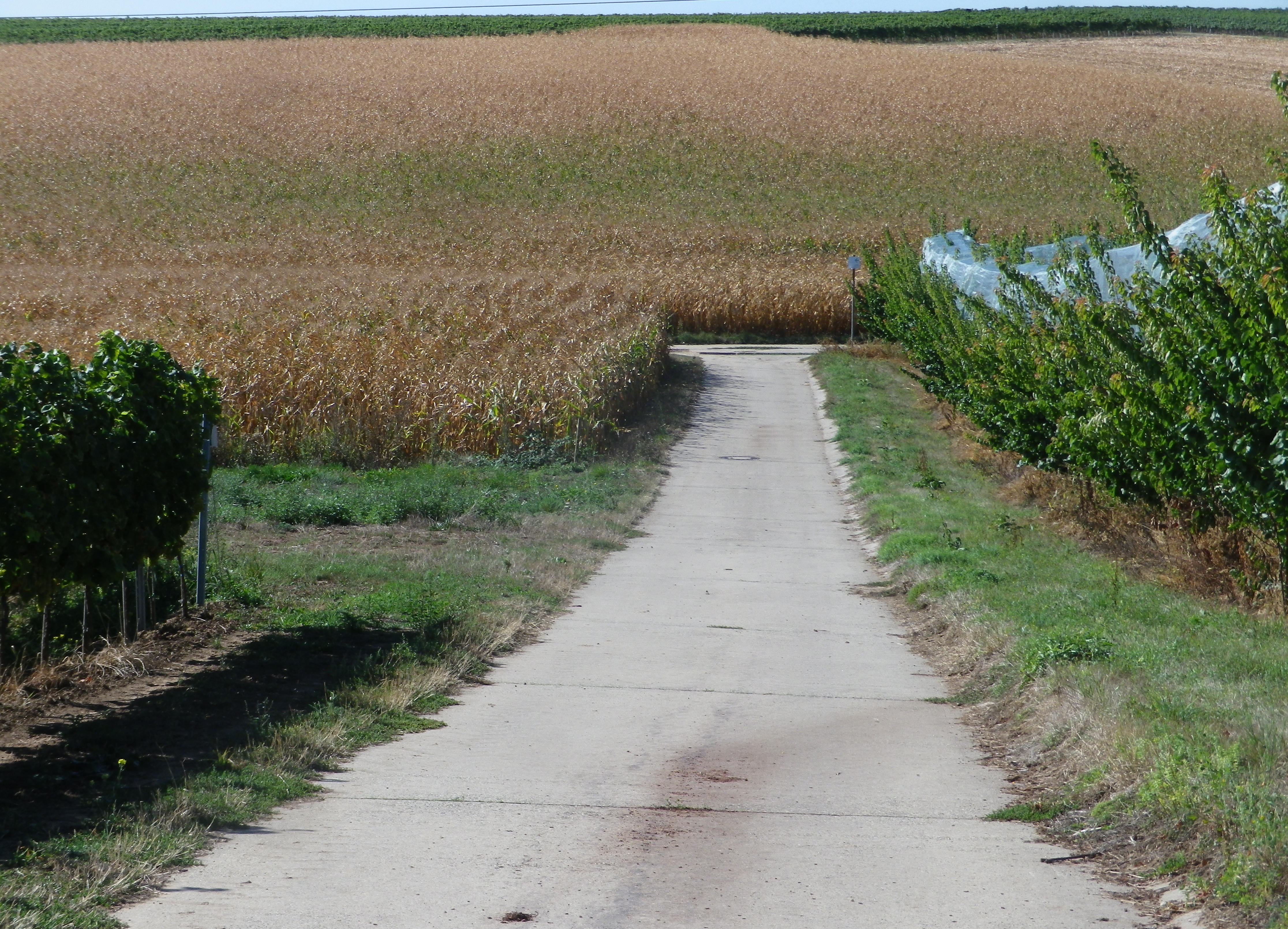
Going through the first vineyards, I noticed that harvest had yet to begin. The vegetation, last cut back weeks ago, while trim, was lush and now filled out. The grape bunches hung heavily on the vines. These vineyards while full of grapes, were empty of people. Presumably, the vintners were at the wineries, busy preparing the equipment and cellars for the harvest soon to come.
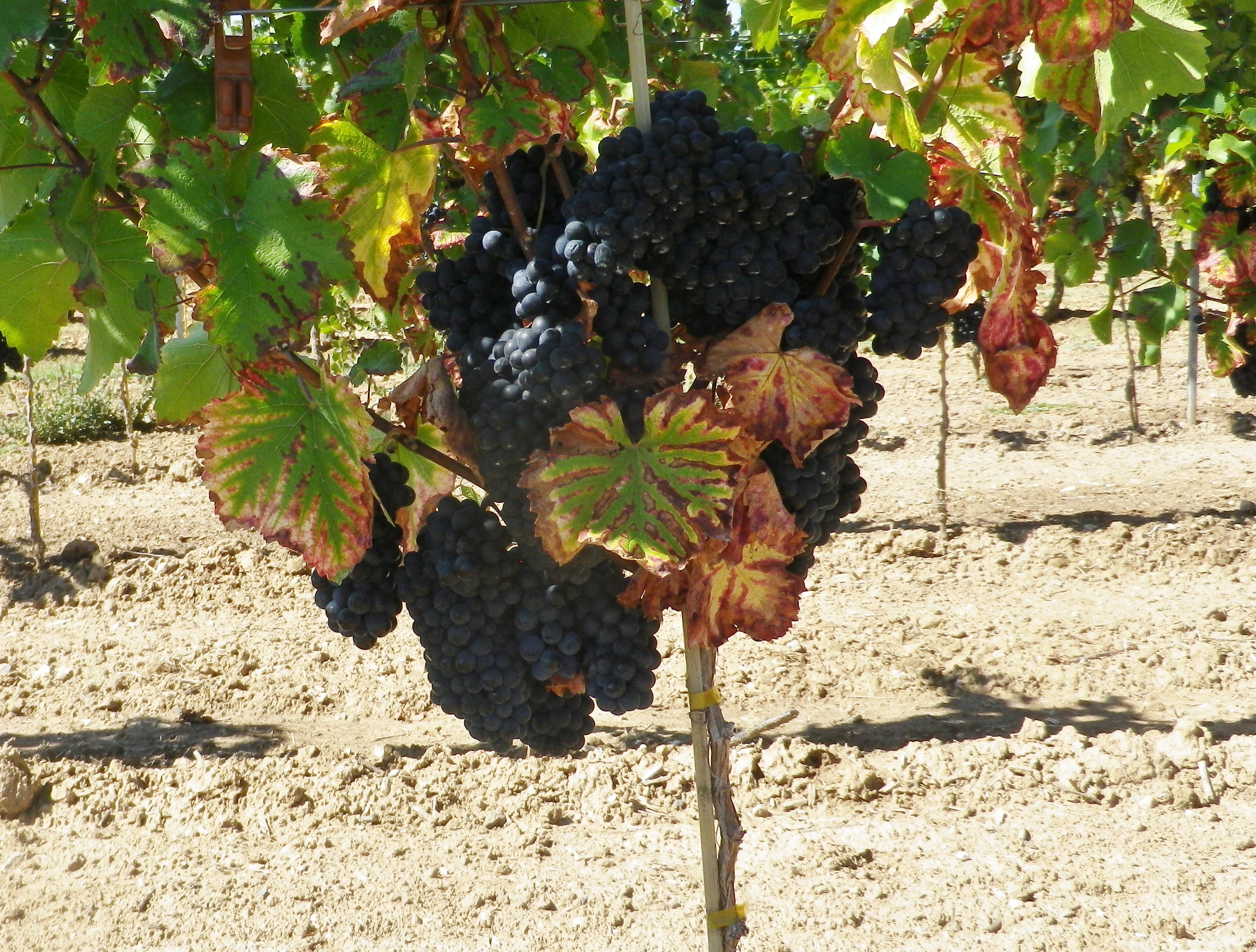
At first, the vineyards were interspersed with corn or vegetable fields in the flat areas in between. This area is one of the “garden” spots of Germany, so there is a diverse agricultural scene here. This was especially true around the villages of Insheim, Knoeringen and Dammheim. But that began to change as the trail approached the base of the Haardt mountains.
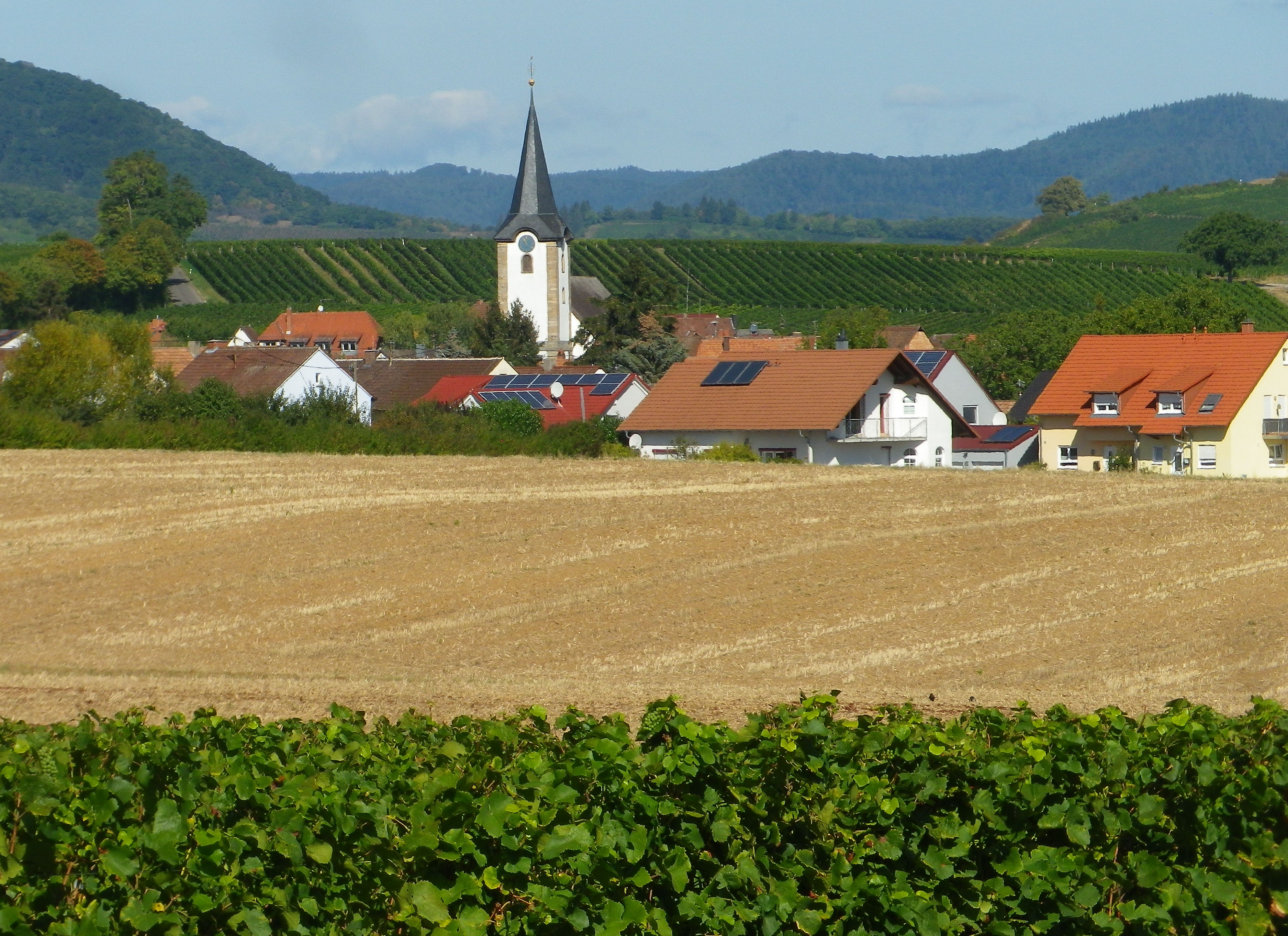
The vineyards predominate once west of the village of Moerzheim. Kilometers of vineyards, each sited with precision, arrayed magnificently along the vintner lanes, which were proving ideal for cycling. The lush green vegetation looked gorgeous under a brilliant sun and a clear blue sky. They were interrupted only by the neat and compact winemaking villages of Wollmesheim, Ilbesheim and Arzheim. Once I reached Siebeldingen, I was at the home of German grape varietal development, the Institut fuer Rebenzuechtung, where experimental new varietals are scientifically engineered, cultivated and tested every year.
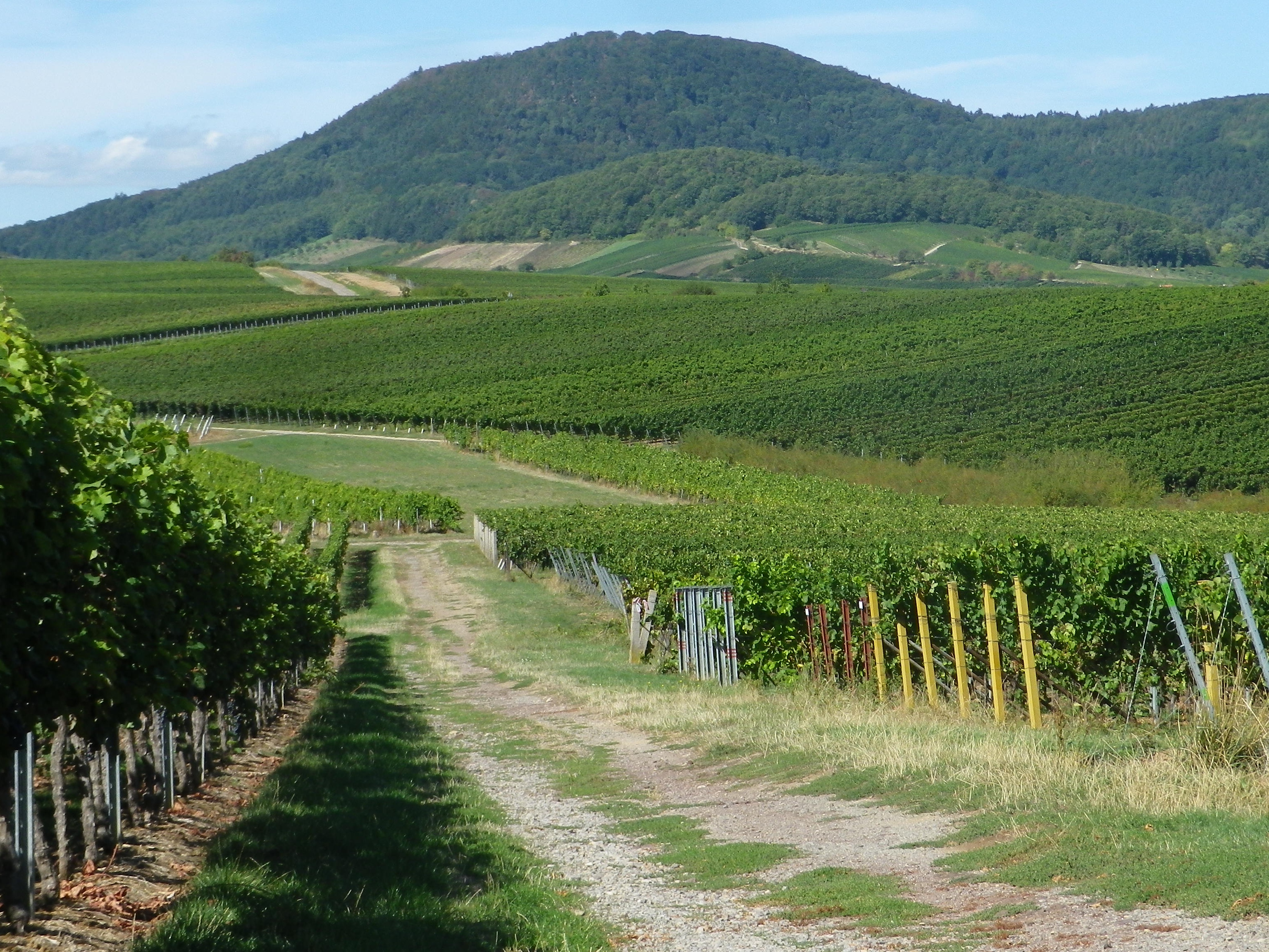
The itinerary followed up and over ridgeline after ridgeline. On top of each ridgeline, the views were tremendous. The flat lands of the Rhine River Valley stretched east to Baden-Wuerttemburg, where the base of its tree-lined ridges stood out well on this crystal-clear day. Seemingly near enough to touch, stood the Haardt mountains to the west. Some of its beloved red sandstone landmarks clearly stood out against its dark pines. There could not have been a better day for cycling this trail.
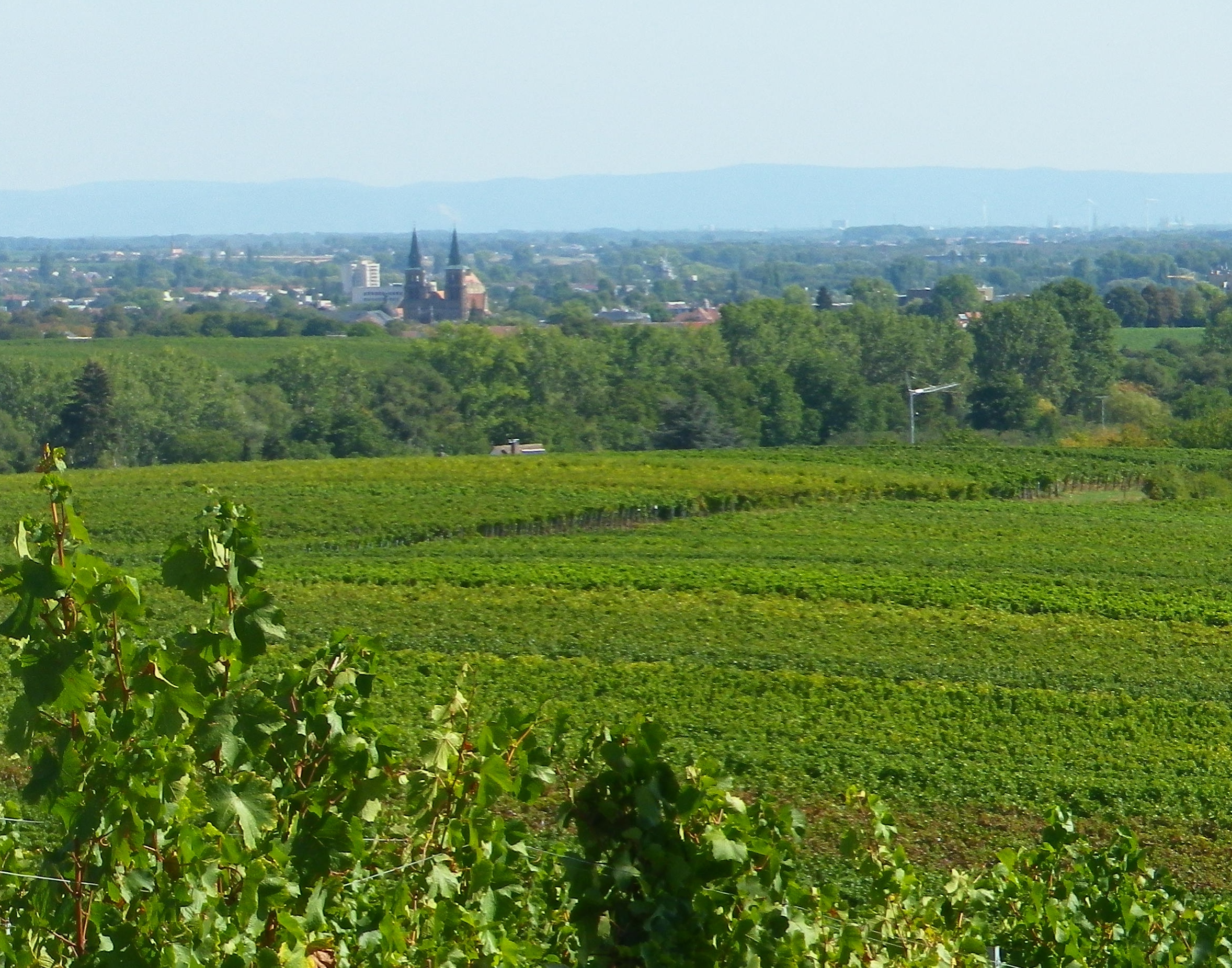
The occasional village provided opportunities for something to eat or drink. But the village of Nussdorf really stood out. Set in a sea of vines, this little village which once sheltered Roman-era vintners, really celebrated its viticultural heritage. Nussdorf’s unique wine education trail (Weinerlebnispfad), complete with picnic benches, a wading pool for aching feet (Kneipp), and a rest area, also partly served as the itinerary for this section of the Winzer Radrundweg. There were several sculptures celebrating the life of the vine, and chimes lined the trail, awaiting the inspirational touch of passersby to bring sound to the vineyard. Flowers, usually roses, marked the end of rows of vines. (Historically, vintners used flowers to lure insects away from the vines, thus protecting them.) Speaking of celebrating, in addition to hosting several wine festivals throughout the year, some enterprising local vintner also had what looked like a large prairie schooner (Planwagen), apparently rented by a group of partygoers, enjoying the local wines as they were drawn along the wine trail.
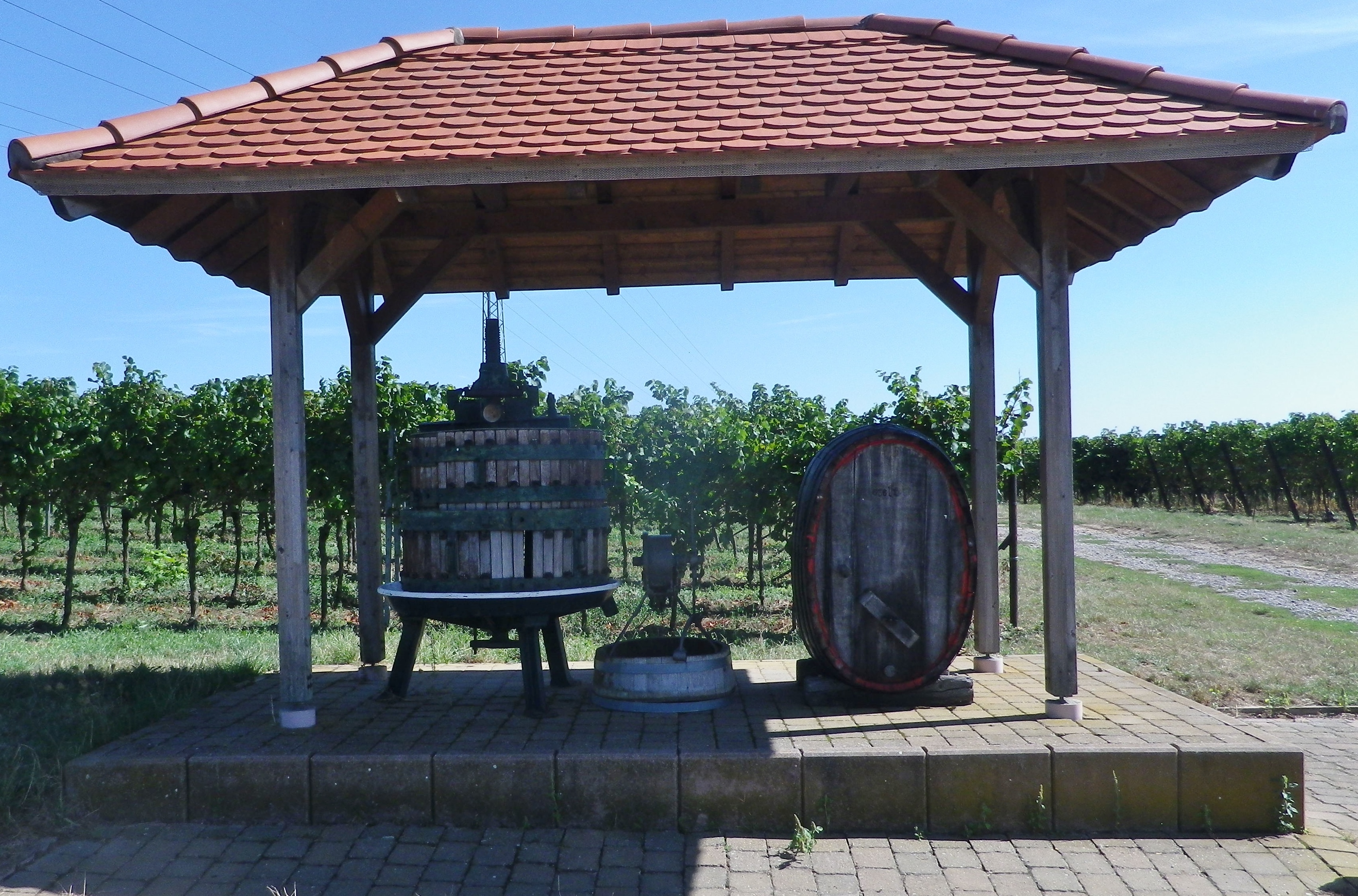
A good time on the trail was had by all that day, especially by me. This trail provided a wealth of sights and sounds, a variety of landscapes, and above all, a variety of wines to sample and enjoy!
Wine notes: Pfalz’s Suedliche Weinstrasse
What I Learned:
The Pfalz Wine Region has a long history of wine making. The pressing room and vats at the Weilberg Roman Winery (Römische Weingut Weilberg), near Bad Duerkheim, and the implements found throughout various sites all along the Deutsche Weinstrasse, testify to this long history.
The tradition continued with the establishment of regional monasteries, such as the ones in Klingenmuster and Wissembourg dating to the 600s. This was especially true along the Pfalz’s Suedliche Weinstrasse. Wissembourg was a rich and powerful monastery in its day. In today’s Edesheim, the abbey owned the “Villa Auduino,” which consisted of an agricultural manor house and two churches. In Nussdorf, the Monastery of Fulda (far to the north) owned its own manor house. These places were important to the monks, not just for providing food products, but also for their wines, which they needed for liturgical services.
Hence, in the Suedliche Weinstrasse district, winemaking has been an important economic activity for about 2000 years. Not only has this area had an uninterrupted history of winemaking, it also continues to modify and improve its traditions over time.
Siebeldingen’s Institut fuer Rebenzuechtung (Institute for Grape Cultivation) Geilweilerhof (the building itself a former cloister) is an invaluable resource in this regard. The institute maintains databases on grape varietals, and has test cellars to make and test wines from new varietals. This all supports its main function: to develop new varietals, genetically resistant to climatic changes and pests.
Some of its older creations will be familiar to lovers of German wines: the white varietals of Morio-Muskat and Bacchus, and the red varietals of Domina and Regent (two of the most flavorful and powerful German red wines, IMHO). One of the newest grapes to come onto market as wine is the white Calardis Blanc, a cross between a Bacchus and Seyval Blanc, and a Seyve Villard. (Finding a bottle will be a challenge for a few years to come, so head to the Institute’s wine shop in Siebeldingen for now!)
Over 125 varietals are planted in the Pfalz wine region, to include the ones listed above! But only half a dozen or so make up over 60 percent of the plantings. Riesling has always played an important role, but more so in the northern part of the Pfalz wine region. Mueller Thurgau is also an important white varietal, especially so in the south. Weissburgunder (Pinot Blanc) is another white wine grape that is planted here, although in far smaller quantities. As for the red varietals, there is Dornfelder, the most widely cultivated red wine grape locally. As a percentage of red wine grapes grown, it has overtaken the traditional favorite: Portugieser. Spaetburgunder, aka Pinot Noir, represents a full 7% of the grapes planted, and is gaining in popularity.
What I Tasted:
2017 Gruener Silvaner, Ortswein, Trocken, Weingut Voegeli (Wollmesheim): A dry white wine with a medium yellow gold color; a mineral nose, with herbal, grass, spice and slight pear flavors; medium acidity, with a tangy finish.
2017 Chardonnay, Lagewein, Trocken, Weingut Voegeli: A dry white wine with a medium white gold color; a peach, honey and mineral nose, with peach, pear and floral flavor; medium acidity, with a smooth finish.
2016 Riesling, Lagewein, Trocken, Weingut Voegeli: A dry white wine with a medium gold color; a slight mineral and turpentine nose, with spice and green apple flavors, medium plus acidity, with a crisp, tart finish.
2012 Weissburgunder Sekt: Weingut Wilhelmshof, (Siebeldingen): A sparkling white wine with lively, persistent perlage and medium gold color; a powerful fruity nose, with powerful fruity grape and white stone fruits flavors, a medium and sweet finish.
Winzer Radrundweg: Trail in a Nutshell
Trail Name: Winzer Radrundweg
Trail Type: Medium distance circuit cycling itinerary; well-maintained and mostly paved trail surfaces, albeit with a couple of grass paths, and a few hard-packed earth surface sections, marking on the trail for the specific itinerary is sporadic.
Length:
Total – 44 kilometers/27.3 miles
Convenient to: Landau in der Pfalz, Germany
Marking: A white sign with stylized circles forming a grape cluster with two stylized riders on top
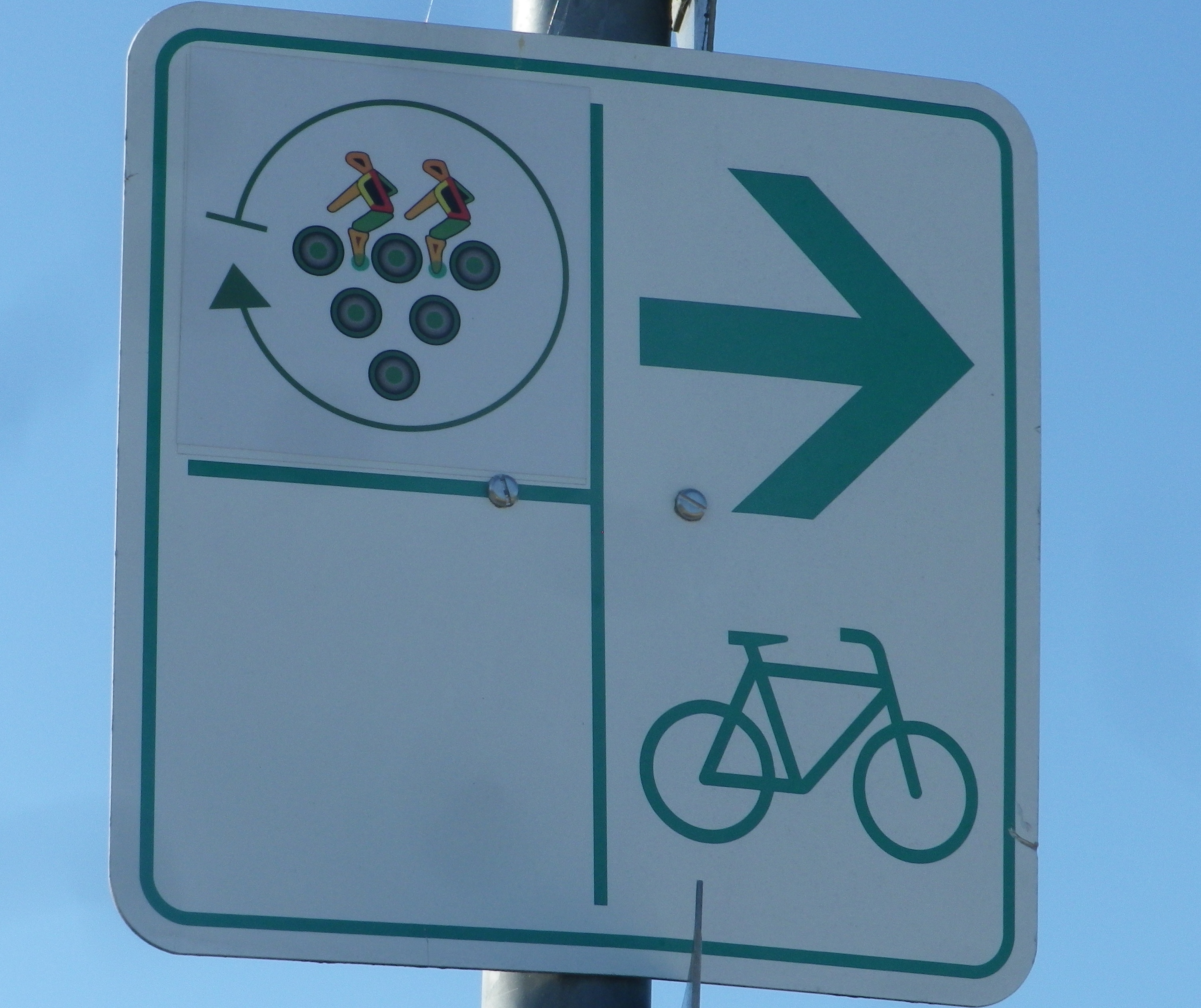
Trail Description: A delightful medium-length circuit primarily through vineyards, circling around the smaller, and lesser known (hence quieter and not as tourist-filled) wine villages of the southern part of Deutsche Weinstrasse.
Trailhead:
Official: Siebeldingen: Bismarckstr
Mine: Laundau: L509 Queichheim Hauptstr, at the Landau Zentrum exit off A65
Parking:
Insheim: Bahnhofstr;
Moerlheim (at exit Landau-Zentrum): P+R (just east of exit)
Landau: parking in and around the Freizeitbad (a water park) and the nearby Stettiner Str
Public Transportation Options:
Rail: Deutsche Bahn has frequent rail service connecting Landau with the main Rhine Valley cities via Karlsruhe.
Bus: VRN (Verkehrsverbund Rhein-Neckar) has bus lines connecting Landau and/or Bad Bergzabern (both with frequent train service) to the smaller towns and villages on this itinerary.
Suggested Stages: Not applicable
Trail Itinerary-Reference Points: (Counterclockwise)
Landau: Horststr, Horstring, Am Kugelfang; Dammheim: Am Bahnhofstr, Alte Bahnhofstr, Dorfstr, Schmiedstr; through fields, along A65; Knoeringen: Bahnhofstr, Hauptstr, Kirchstr; Walsheim: Hauptstr; through fields; Nussdorf: Kirchstr, Lindenbergstr, Am Heimlichen Eck, Kaiserberg, along Weinerlebnis Pfad; Godramstein: Unterer Steinweg, Bornergasse (P), Frankweilerstr, Kapellenweg, L511; Siebeldingen: Jahnstr, along Queich creek, outskirts; Arzheim: Hauptstr-Kalmitstr, Kapellenstr, Erzabt-Josef-Koch-Str, Ilbesheim bei Landau: Arzheimerstr, Hauptstr, Moerzheimer Str; Wollmesheim: Wollmesheimer Hauptstr, L510/Moerzheimerstr; Moerzheim: cross K6 (or turn left) Goecklinger Weg, Zum Kirchweg, Herrenstr, Unterstr, Bruehlstr, Augartenweg, fields; Impflingen: Obergasse-Bruchgasse, In der Kuhweide, fields; Insheim: Sportplatzstr, Kettelerstr, Kandeler Str-Sandweg, past train station (P), Bodelschwingstr, Offenbacherstr; Along, then over A65; Moerlheim: Moerlheimer Str; Queichheim-Landau: Queichheimer Hauptstr (P); Landau: Hauptbahnhof (P)
Representative Trail Photos:
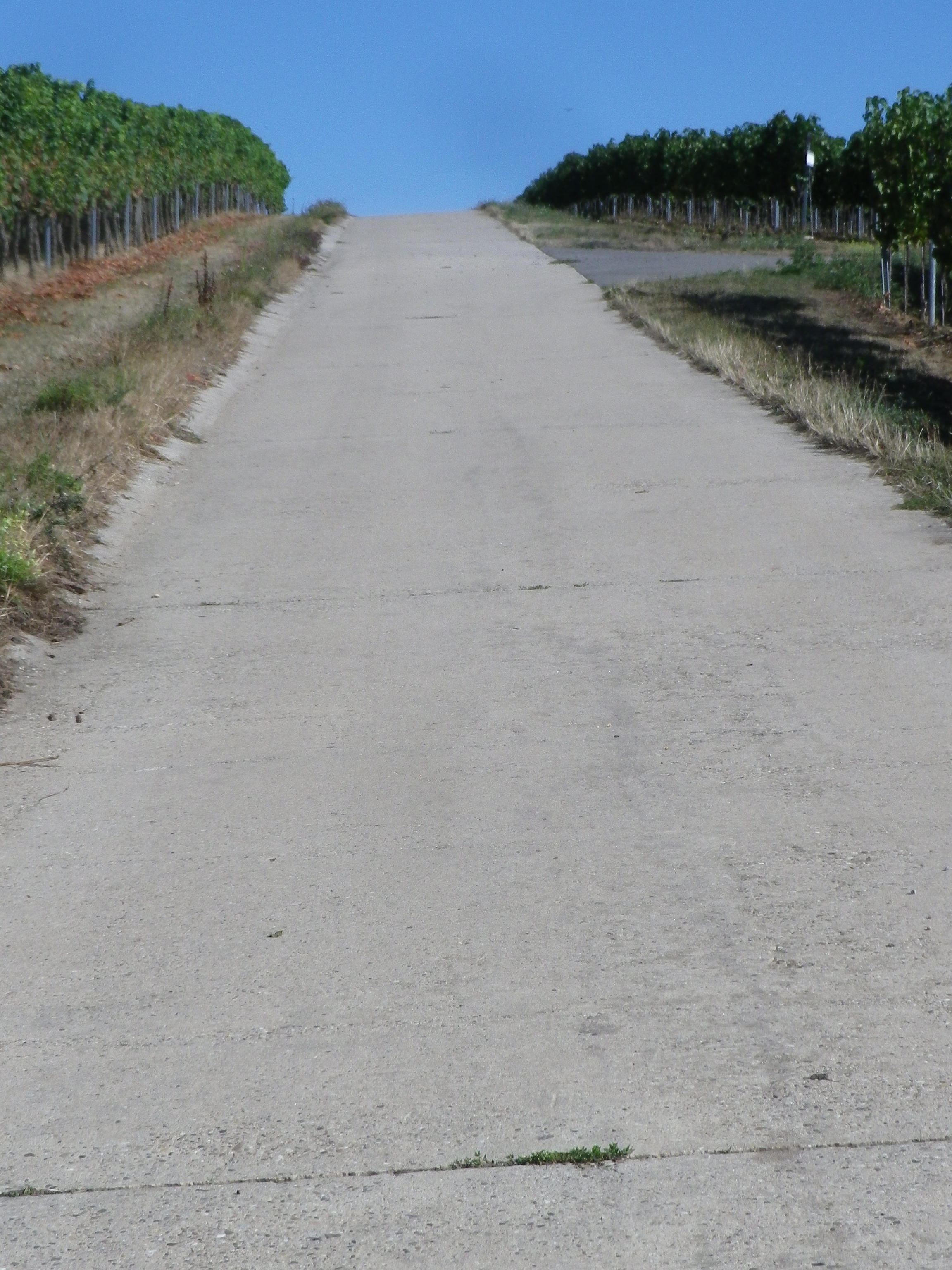
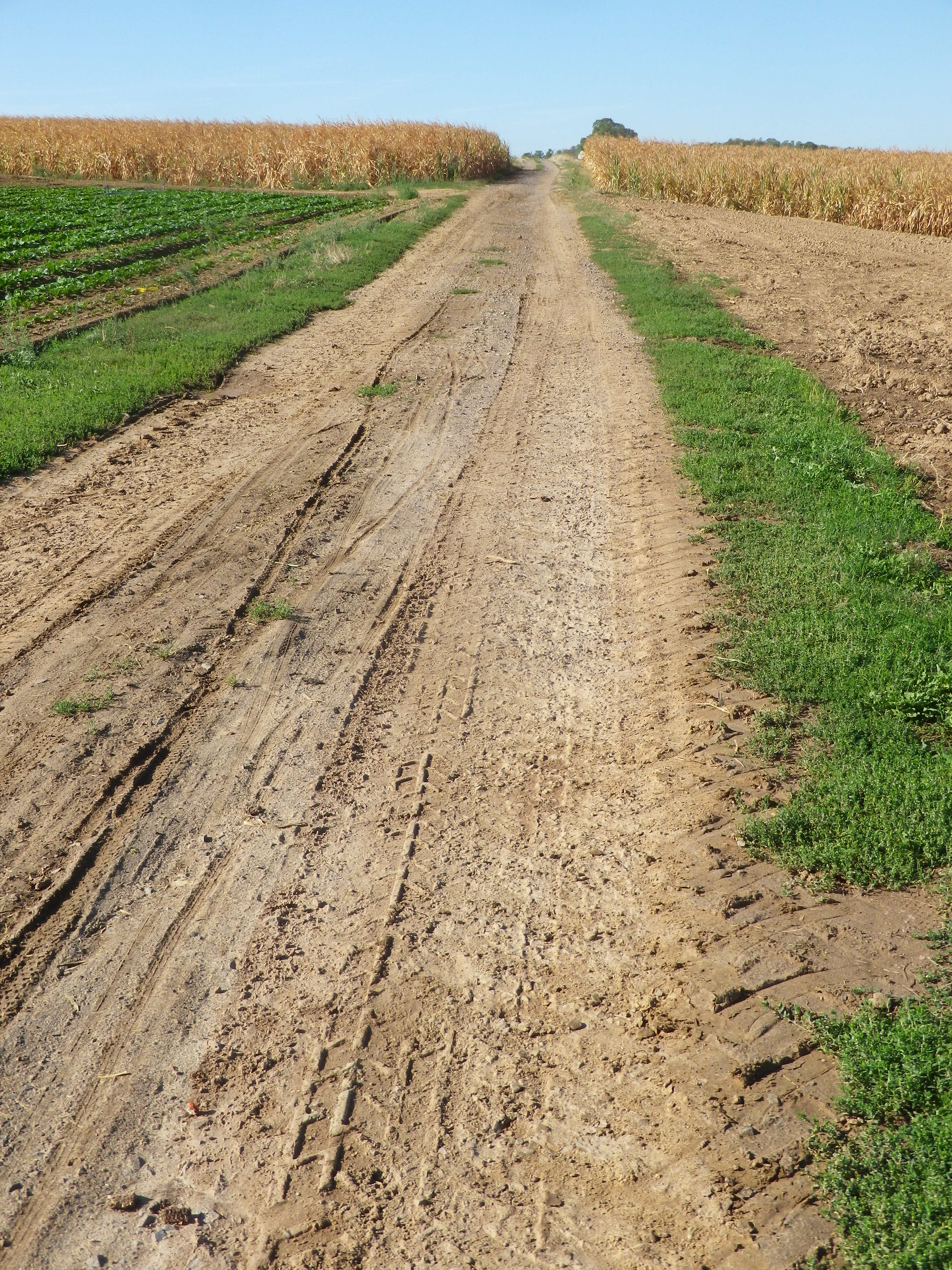
Restrooms:
Nussdorf: On the Weinerlebnispfad, in the vineyards is a small restroom set in a nice rest area.
Landau: Off the trail (but closest and pay) toilets at Am Kronwerk x Fortstr (make sure you have coins)
Attractions on or near Trail:
Seasonal local wine festivals (see below), and wine education paths Nussdorf and Siebeldingen
Tasting along the Trail:
Many wineries along the trail, most notably in Siebeldingen, Nussdorf, Ilbesheim and Godramstein; whereas Landau has a couple of wine taverns/vinoteks. Additionally, Ilbesheim, Heuchelheim-Klingen, Siebeldingen have wine festivals in September
Alternative Options:
Hiking: In Heuchelheim-Klingen, the Weinrundwanderweg, a 13.6-kilometer-long easy circuit hike through the two villages surrounded by a sea of vines. Ilbesheim, by contrast has a number of wine-themed short (2-3 kilometer) circuits. Last but not least is Nussdorf’s Weinerlebnispfad, a unique combination of visual and audio art set in the vineyards along a two-kilometer trail through the vineyards overlooking the mountains and valleys of the Pfalz.
Car: Deutsche Weinstrasse, a thematic car route itinerary of about 100 kilometers, much of it on secondary roads, past vineyards and through charming wine villages, from Bockenheim to the border town of Schweigen-Rechtenbach.)
Additional Information:
Regional: https://landauland.suedlicheweinstrasse.de/
Trail specific: https://www.outdooractive.com/de/route/radtour/pfalz/winzer-radrundweg/3201806/ or
https://vis-a-vis-pamina.eu/en/activities/
Comments:
Not a lot of shade, so perhaps best in cooler weather.
A couple of short, but steep inclines. However, overall, this is an easy to medium difficulty trail.
I included the earthen trail surface photo above to show that even the most degraded surface on this itinerary is quite suitable for most bicycles, except perhaps directly after a very heavy or prolonged rain.
A Spring Warm-Up in the Pfalz
Spring blooms relatively early in the southern Pfalz. First, and perhaps the most spectacular of all, are the almond blossoms. Beginning in early March and continuing until mid-April, the profuse, brilliantly pink flowers seen against a cerulean blue sky, are a gorgeous sight. This magnificent spectacle prompted a long-distance hiking trail entitled the Pfaelzer Mandelpfad, or the Pfalz Almond Trail. While I unfortunately arrived just as the pink almond blossoms had faded, I could see the next tree blossoms on deck: the delicately colored white apple tree blossoms.
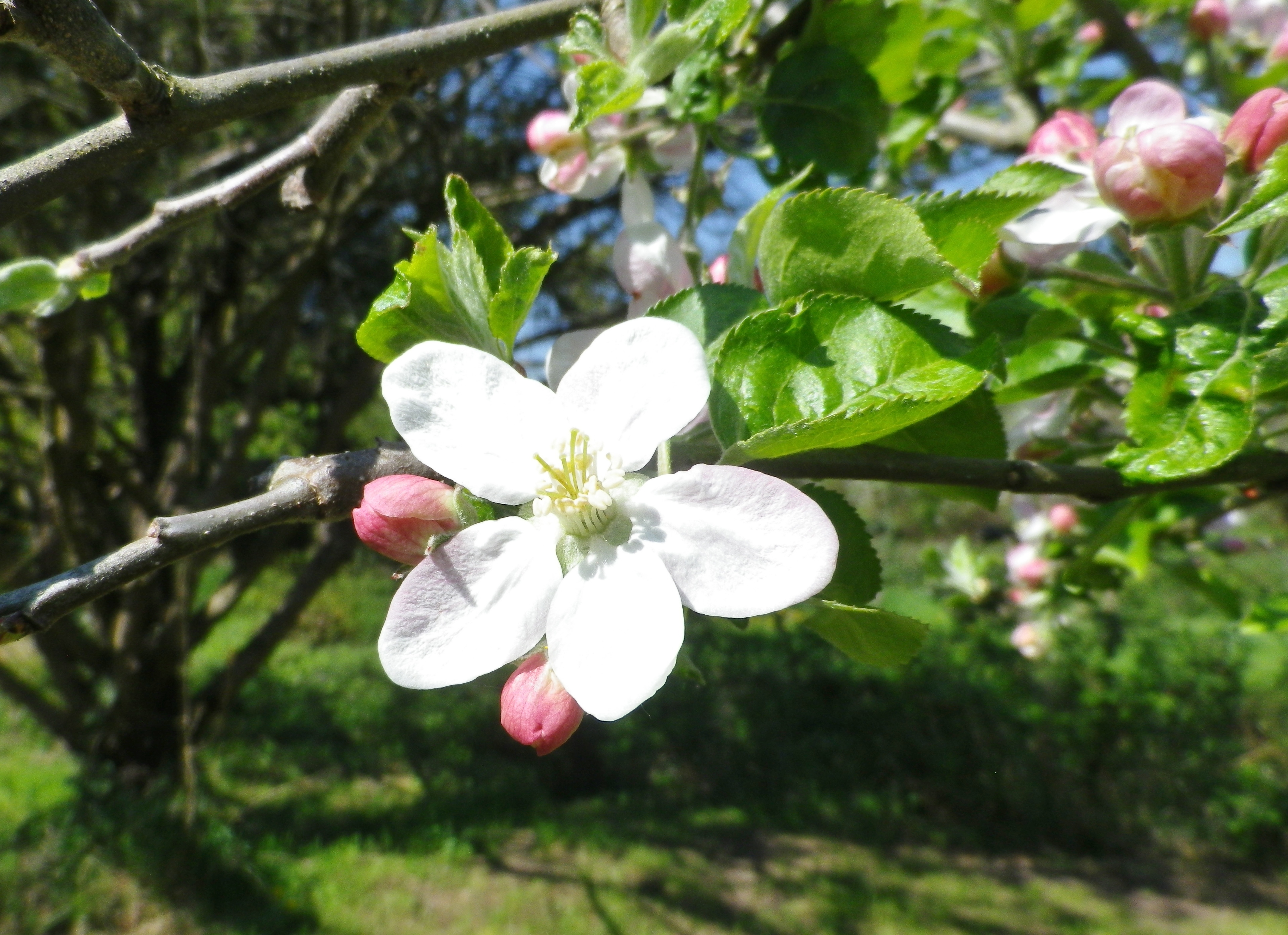
Wine Notes: Pfalz’s Suedliche Weinstrasse
What I Learned
The Pfalz has more hectares (about 23, 600) under vine than any other wine region in Germany, except Rheinhessen. It is divided into two districts: the Mittelhaardt, and the Suedliche Weinstrasse. White wine varietals, of which there are over 70 different types, predominate, especially Riesling, but red wine varietals are increasing, now with over 50 types, in proportion to the white varietals.
In the Suedliche Weinstrasse district, the Deutsche Weintor Winery (Winzergenossenschaft) primarily serves the Suedliche Weinstrasse district. Founded in 1956, the winery takes its name from Deutsche Weintor, the iconic wine gate in Schweigenhof-Rechtenbach on the French border, which marked the end of German’s first car tourism Route: The German Wine Road (Deutsche Weinstrasse). A popular tourist site, many people are familiar with the Deutsches Weintor vinothek there. However, its cellar, begun in 1957, is a bit further north, in Ilbesheim bei Landau. It likewise has a vinothek. Nowadays, with over 600 wine growers, and over 850 hectares, the Deutsche Weintor Winery dominates the wine production of this area.
